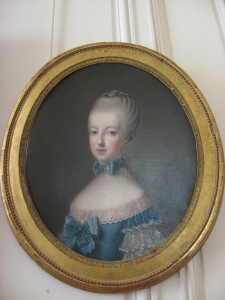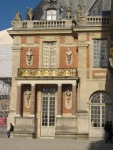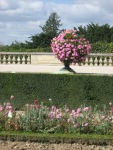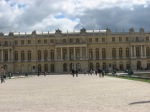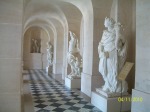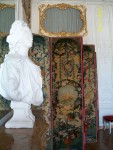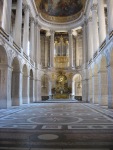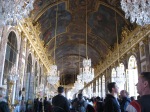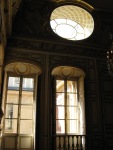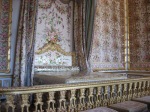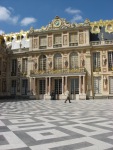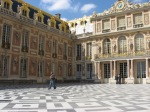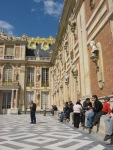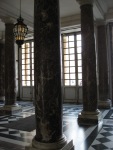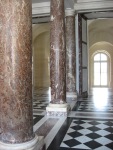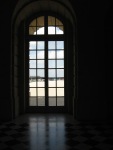Versailles is known for being one of the most magnificent palaces in the world, the seat of one of Europe’s most flamboyant monarchies, and a place where history was made. Here, Louis XIV built an architectural symbol of his power, grandeur, and exceptionally Baroque tastes. The ceilings were painted with exquisite (if a little overblown) allegorical paintings. The state apartments were a string of rooms, each grander than the last and each named after the Classical god or goddess who best fit with a specific theme. For instance, the Mars Drawing Room has paintings of, well, Mars the god of war but also paintings about war itself, such as one of Alexander the Great.
By the time of the Affair of the Diamond Necklace, Versailles was a bit old-fashioned. So many people came and went, and hygiene was so little heeded, that the place must have been pretty awful at times. Luckily, the official rooms were only a small portion of the palace, and there were private rooms behind them. It still must have been a very impressive place, and it was, at this time, still the seat of an absolute monarchy.
Before the storm of the Diamond Necklace Affair hit, Madame de La Motte was actually a frequent visitor to the Chateau de Versailles. It was here that she had to bring her appeals for more money. She was a distant relative of the king–very distant. So distant that she wasn’t given much of a hearing, especially since she’d already been granted a

The Chateau de Versailles
stipend by the crown. Shortly before concocting her plan for pulling the wool over the eyes of a Cardinal of the Church, Madame de La Motte could be found importuning the finance ministers. Monsieur de Calonne was one such minister. According to Jeanne herself, courtesy of Frances Mossiker’s translation, she was “to hear him propose that I [Madame] share the treasure of his affections . . . with his current official mistress . . . !” Indignant she may have been, but one suspects that she might have encouraged M. Colonne’s advances (at the very least), because he apparently made efforts on her behalf. She likened it to the mountain that labored to bring forth a mouse; nothing came of his efforts.
Her next effort was a kind of sit-in. She refused to move from Calonne’s office until he gave her money. She got a small cash award.
It wasn’t long before Jeanne, her husband, her “personal secretary” Retaux de Villette, or someone near her, came up with the cunning plan of fooling people into believing that Jeanne was a close friend of the Queen. The idea was simple enough: Jeanne would tell people (falsely of course–Her Majesty would never see someone like Jeanne who had no real rank) that she had the Queen’s ear. Jeanne would agree to personally speak to the Queen on behalf of other people–of course, a small gift of thanks would be expected.
Soon, her plans became more ambitious to include Cardinal Prince Louis de Rohan, an old acquaintance of the woman who acted as Jeanne’s foster mother. The Cardinal was more susceptible than most to this scheme. He had lost the Queen’s favor years ago and now wanted it back. He was fabulously wealthy and could be fooled into parting with large chunks of cash.
But how does one fool a Cardinal?
Versailles was the backdrop to several clever deceptions–or not so clever, really, since they ought to have been obvious to Cardinal Rohan.
The first ploy was simple enough. Jeanne would come traipsing away from the Petite Trianon Palace (Marie-Antoinette’s retreat) at just the right time to be seen. Those who saw her would presume that Jeanne had just come from a personal interview with Her Majesty. After all, only the Queen’s closest friends were allowed to go to the Petite Trianon, and Jeanne had just been there. Of course, that wasn’t the case. All she did was walk to the palace, then start walking away again at just the right time as though she were just leaving a tete-a-tete with the Queen.
The second ploy was subtler but no less obvious, unless one were desperate to believe. On her way to Mass, the Queen

The bull's-eye window of the Oeil-de-Boeuf Room
passed through the State Apartments at Versailles. As she went, she would nod to the crowd in acknowledgment. Jeanne made use of this habitual nod. She told Cardinal Rohan to go to the Oeil-de-Boeuf Room (so named because of the “bull’s eye window” in the room), where he would receive a nod from Marie-Antoinette as a confirmation that he was in favor with her. The Queen nodded and he believed that she nodded at him.
The third ploy is the Grove of Venus scene. A more complete story can be found in other entries on this blog, but the basic idea is this: Cardinal Rohan’s faith wavered and he asked for some kind of confirmation from the Queen in person. Jeanne arranged this. She hired a whore to play the part of Her Majesty (the whore was name Nicole d’Oliva), and on a summer’s night, the Cardinal and the prostitute met. She handed him a rose and told him, “You know what this means.” Well, he thought he knew what it meant, though he was certainly wrong. He fell for the entire thing, hook, line, and sinker, so that later on, when he was asked to sign on as guarantor for the purchase of a massively expensive diamond necklace, he agreed to do it.
The Chateau’s was one of the most prominent backdrops for the Affair of the Diamond Necklace. If I were making a play based on the Affair, one of the sets would have to be Versailles. The essence of the place–its history, associations, and grandeur–lent credibility to Jeanne’s lies. It was the perfect distraction for the sleight of hand that was really going on.
